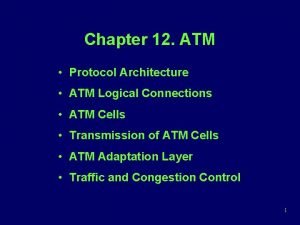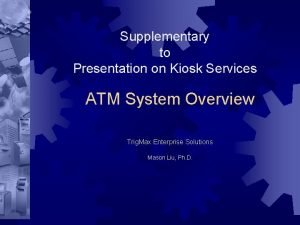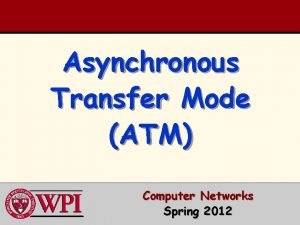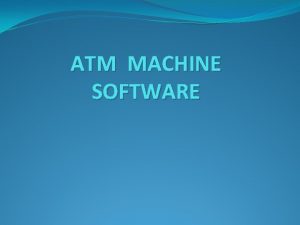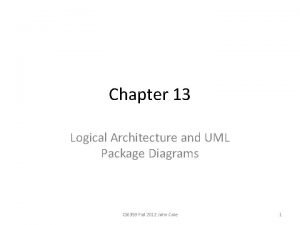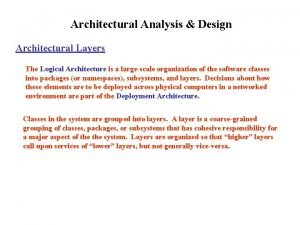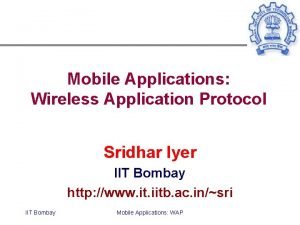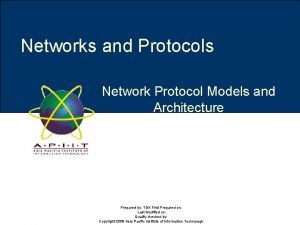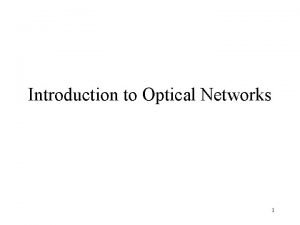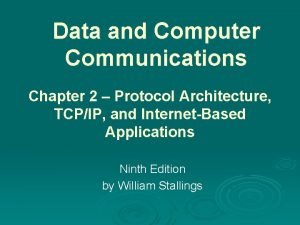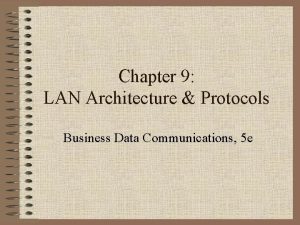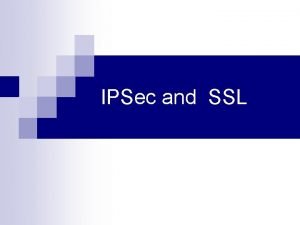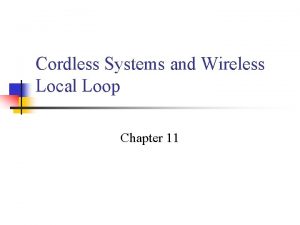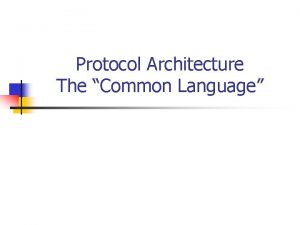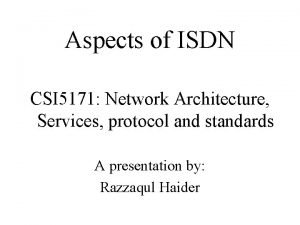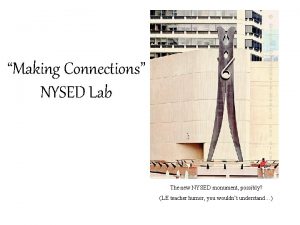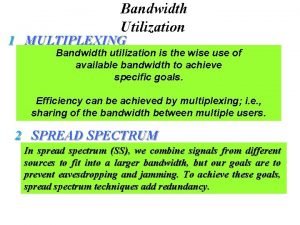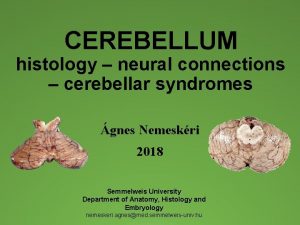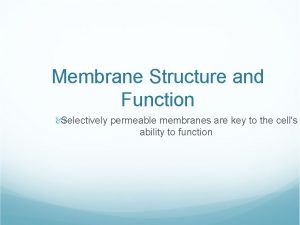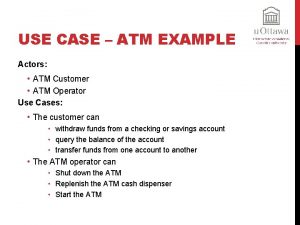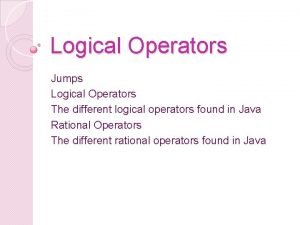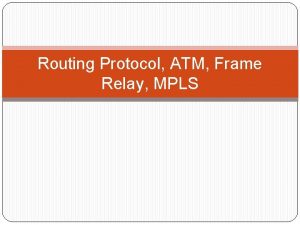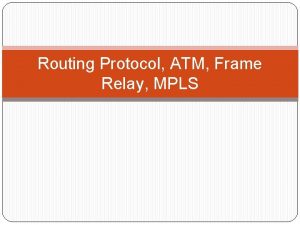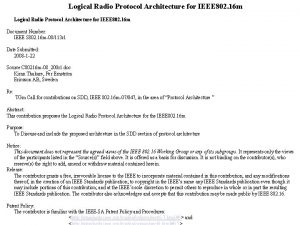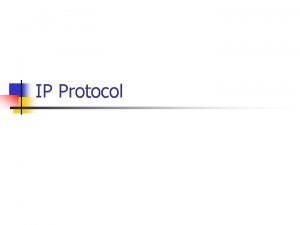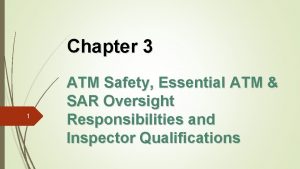Chapter 12 ATM Protocol Architecture ATM Logical Connections

































































- Slides: 65

Chapter 12. ATM • Protocol Architecture • ATM Logical Connections • ATM Cells • Transmission of ATM Cells • ATM Adaptation Layer • Traffic and Congestion Control 1

Protocol Architecture • Issued by ITU-T • 155. 52 Mbps (OC-3), 622. 08 Mbps (OC-12) • Three separate planes – User plane: for user information transfer – Control plane: call/connection control functions – Management plane: management functions 2

Protocol Architecture (cont) 3

Virtual Channel Terminology 4

Virtual Path Terminology VPI 5

ATM Connection Relationships 6

ATM Logical Connections • Virtual Channel Connection (VCC) – Analogous to virtual circuit in X. 25, or data link connection in frame relay – A VCC is set up between two end users through the network – VCCs are also used for user-network exchange (control signaling) and network-network exchange (network management) • Virtual path connection (VPC) – a bundle of VCCs that have the same endpoints 7

Advantage of Virtual Paths • Simplified network architecture • Increased network performance and reliability • Reduced processing and short connection setup time • Enhanced network services 8

Call Establishment 9

Virtual Channel Connection Users • Between end users – To carry end-to-end user data – Can also be used to carry control signaling between end users • Between an end user and a network entity – Used for user-to-network control signaling • Between two network entities – Used for traffic management and routing functions 10

Virtual Path Connection Users • Between end users – VPC provides them with an overall capacity – The VCC organization of the VPC is up to the two end users, provided the set of VCCs does not exceed the VPC capacity • Between an end user and a network entity – VPC can be used to aggregate traffic from an end user to a network exchange or server • Between two network entities – VPC can be used to define a common route for the exchange of network management info. 11

VP/VC Characteristics • Quality of services – Cell loss ratio, Cell delay variation • Switched and semi-permanent virtual channel connections • Cell sequence integrity • Traffic parameter negotiation and usage monitoring – avg. rate, peak rate, burstiness, peak duration • VCI restriction within a VPC 12

VP/VC Switching VPI 1 VPI 3 VCI 1 VCI 2 VCI 3 VPI 2 VPI 4 VCI 1 VCI 2 VCI 3 VPI 3 VCI 4 VPI 1 VCI 2 VCI 3 VCI 4 VPI 2 VCI 1 VCI 2 VCI 3 VPI 5 VCI 1 VCI 2 13

ATM Control Signaling • Methods for providing an establishment/ release facility – Semi-permanent VCCs • If used for user-to-user exchange, no control signaling is required – Meta-signaling channel • Permanent channel, probably of low data rate • Can be used to set up VCCs that can be used for call control 14

ATM Control Signaling (cont) – User-to-network signaling virtual channel • Set up via meta-signaling channel • Can be used to set up VCCs to carry user data – User-to-user signaling virtual channel • Set up via meta-signalling channel • Set up within a pre-established VPC • Can be used to allow the two end users, without network intervention, to establish and release user-to -user VCCs to carry user data 15

ATM Cells 16

ATM Cells (cont) • Generic flow control (GFC) – Only at user-network interface – Used to alleviate short-term overload condition – Part of a proposed controlled cell transfer (CCT) • Virtual path identifier (VPI) – constitutes a routing field for the network • Virtual channel identifier (VCI) – used for routing to and from end users • Payload type (PT) – indicates the type of information in the cell 17

ATM Cells (cont) Two directions Flow control is exercised in the direction from the subscriber to the network by the network side 18

ATM Cells (cont) 19

ATM Cells (cont) • The first bit in PT field – Value 0: indicates user information • In this case, the second bit indicates whether congestion has been experienced; • The third bit: the service data unit (SDU) type bit (ATM-user-to-ATM-user (AAU) indication bit) – Value 1: the cell carries network management or maintenance information • This indication allows the insertion of networkmanagement cells into a user’s VCC without impacting the user’s data, thereby providing in-band control information 20

ATM Cells (cont) • Cell-loss priority (CLP) – used to provide guidance to the network in the event of congestion – CLP = 0 indicates a cell of relatively high priority, which should be discarded only when no other alternative is available – CLP = 1 indicates this cell is subject to discard • Header Error Control (HEC) – 8 bits HEC based on the remaining 32 bits of the header 21

Header Error Control Default mode 22

Transmission of ATM Cells • Cell-based physical layer – Synchronization on the basis of HEC 23

Cell-delineation Performance 24

Synchronization Acquisition time 25

SDH-Based Transmission 26

SDH-Based Transmission • Advantage – Can be used to carry either ATM-based or STMbased (synchronous transmission mode) payloads – Some specific connections can be circuitswitched using an SDH channel – Using SDH synchronous multiplexing techniques, several ATM streams can be combined to build interfaces with higher bit rates. E. g. 4*STM-1 STM-4 (622 -Mbps) 27

ATM Service Categories • Real-time service – Concerns the amount of delay and the variability of delay, i. e. jitter – Constant bit rate (CBR) • Tight upper bound on transfer delay • E. g. Videoconferencing, Interactive audio, etc. – Real-time variable bit rate (rt-VBR) • Bursty source 28

ATM Service Categories (cont) • Non-real-time service – Non-real-time variable bit rate (nrt-VBR) • Peak cell rate • Sustainable, or average cell rate • How bursty or clumped the cells may be – Available bit rate (ABR) • Peak cell rate, minimum cell rate (MCR) • Any unused capacity is shared in a fair and controlled fashion among all ABR sources – Unspecified bit rate (UBR) • Best-effort service 29

ATM Bit Rate Services 30

ATM Adaptation Layer • Support information transfer protocols not based on ATM Circuit emulation VBR video (This classification is no longer found in ITU-T documents) Data transfer 31

AAL Protocols and Services 32

Applications vs. AAL • Circuit emulation: AAL 1, CBR • VBR voice and video: AAL 2, rt-VBR • General data services: AAL 3/4 • IP over ATM: AAL 5, UBR • Multi. Protocol encapsulation Over ATM • LAN emulation: AAL 5 33

AAL Protocols • Organized into two logical sub-layers – Convergence Sub-layer (CS) – Segmentation and Reassembly Sub-layer (SAR) • CS – Provides the functions needed to support specific applications using AAL • SAR – responsible for packaging information received from CS into cells for transmission and unpacking the information at the other end. – SAR must pack any SAR headers and trailers, plus CS information into 48 -octet blocks 34

AAL Protocols and PDUs 35

SAR Protocol Data Unit AAL 1 pointer (1 octet) (Structured data transfer) AAL Type 2 ? 36

SAR PDU- AAL Type 1 • SN: 4 -bit sequence number field – 1 -bit convergence sub-layer indicator (CSI) • If CSI = 1, the AAL 1 pointer is present – 3 -bit sequence count • SNP: 4 -bit sequence number protection – Provide error detection and error correction capabilities for the SN field – 3 bit cyclic redundancy check (CRC) field and 1 -bit parity bit. – Allow to correct all 1 -bit errors and to detect all 2 -bit errors 37

SAR PDU- AAL Type 3/4 • ST: segment type (2 bits) – Used to indicate if the PDU is the • • beginning of message (BOM) (ST = 10), continuation of message (COM) (ST = 00), end of message (EOM) (ST = 01), or single segment message (SSM) (ST = 11) • SN: sequence number (4 bits) – Represents the sequence number modulo-16 of each SAR PDU belonging to the same CPCS PDU • MID: multiplexing identifier (10 bits) – Identifies the CPCS PDU when SAR PDUs from different CPCS PDUs are multiplexed together 38

AAL Type 3/4 CPCS PDU 44 * N octets Make trailer equal to 32 bit 39

AAL Type 5 • For ATM LAN applications • Assumption – Higher layer takes care of connection management – ATM layer produces minimal errors • Goal – Reduce protocol-processing overhead – Reduce transmission overhead – Ensure adaptability to existing transport protocols 40

AAL Type 5 (cont) 48 * N octets CPCS: Common Part CS Pad: makes CPCS PDU become a multiple of 48 octets 41

AAL Type 5 (cont) 42

SAR PDU- AAL Type 5 • No sequence number field – The receiver must assume that all SAR PDUs arrive in the proper order for re-assembly – The CRC field in CPCS PDU is intended to verify such an order • No MID field – It is not possible to interleave cells from different CPCS-PDUs – A CPCS-PDU consists of zero or more consecutive SAR-PDUs with AAU = 0 followed immediately by an SAR-PDU with AAU set to 1 43

SAR PDU- AAL Type 5 (cont) • No LI (Length Indication) field – There is no way for the SAR entity to distinguish between CPCS-PDU octets and filler in the last SAR-PDU – Use the Pad field so that the last bit of the CPCS-trailer occurs as the last bit of the final SAR-PDU 44

Traffic and Congestion Control • Vital to the successful operation of ATM • Currently intense research • Focus on delay-sensitive traffic • Latency/Speed effects • Cell-Delay Variation: by smoothing buffer – 1. Network contribution to cell-delay variation • The only factor that could lead to noticeable celldelay variation within the network is congestion – 2. Cell-delay variation at the UNI 45

Cell Delay Variation at UNI 2 4 7 8 6 3 1 5 1 2 3 4 5 6 7 8 46

Traffic vs. Congestion control • Traffic control functions – Concerned with establishing traffic parameters and enforcing them – Thus, they are concerned with congestion avoidance • Congestion control functions – If traffic control fails, then congestion may occur – Congestion control functions are invoked to respond to and recover from the congestion 47

Traffic and Congestion Control • Objectives listed in ITU-T I. 371 – Support a set of ATM layer Qo. S classes sufficient for all foreseeable network services – The spec. of Qo. S classes should be consistent with network performance parameters currently under study – Not rely on AAL protocols (network service specific), nor on higher layer protocols (application specific) – Minimize network and end-system complexity while maximize network utilization 48

Traffic and Congestion Control (cont) • Four levels of timing (ITU-T) – Cell insertion time – Round-trip propagation time – Connection duration – Long term 49

Traffic and Congestion Control (cont) 50

Traffic Control • Network resource management – Allocates network resources in such a way as to separate traffic flows according to service characteristics – Deals with the use of virtual paths (ITU-T) • user-to-user application – It is the user’s responsibility to assure that the aggregate demand from the VCCs can be accommodated by the VPC • user-to-network application • network-to-network application 51

Traffic Control (cont) – Qo. S parameters • cell loss ratio • cell transfer delay • cell delay variation – With multiple VCCs within the same VPC, we have two options: • Aggregate peak demand • Statistical multiplexing 52

Traffic Control (cont) VCC 1, VCC 2 depends on VPCs b and c VCCs 3, 4, and 5 depends on VPC a 53

Traffic Control (cont) • Connection admission control – The user selects traffic characteristics by selecting a Qo. S from among the Qo. S classes – The network accepts the connection only if it can commit the resource necessary to support that traffic level while at the same time maintaining the agreed upon Qo. S of existing connections – By accepting the connection, the network forms a Traffic contract with the user 54

Traffic Parameters 55

Traffic Control (cont) • Usage parameter control (UPC) – Control of peak cell rate and the associated cell-delay variation – Control of sustainable cell rate and the associated burst tolerance – Uses leaky bucket (traffic policing) mechanism • Priority control (CLP) • Fast resource management – Respond to a request by a user to send a burst 56

Traffic Control (cont) • Traffic shaping: token bucket 57

Congestion Control • Selective Cell Discarding – Cells of CLP = 1 are discarded to avoid congestion – Once congestion actually occurs, the network is no longer bound to meet all performance objectives • Explicit Forward Congestion Indication – Invoke actions in higher-layer protocols to adaptively lower the cell rate – via PT field in ATM layer 58

ATM-ABR Traffic Management • Qo. S for CBR, rt-VBR, or nrt-VBR – Traffic contract that specifies the characteristics of the cell flow – UPC performed by the network to enforce the flow – Called open-loop control because of its lack of feedback • Typical non-real-time applications (ABR) – Do not have well-defined traffic characteristics – Perhaps a peak cell rate only – Generally can tolerate unpredictable delays and time-varying throughput 59

ABR Traffic Management • Closed-loop control (CHEN 96) – ABR connections share available capacity – The share of available capacity used by a single ABR connection is dynamic and varies between an agreed minimum cell rate (MCR) and PCR – The network provides feedback to ABR sources so that ABR flow is limited to available capacity – For ABR sources that adapt their transmission rate to the provided feedback, a low cell loss ratio is guaranteed 60

ABR Traffic Management (cont) • Feedback mechanisms – Feedback is provided periodically in the form of a sequence of RM (resource management) cells – Each cell contains three fields that provide feedback to the source: • Congestion indication (CI) bit, no increase (NI) bit, and explicit cell rate (ER) field – ACR: allowed cell rate, MCR: minimum cell rate – PCR: peak cell rate, ICR: initial cell rate 61

ABR Traffic Management (cont) – If CI = 1 • Reduce ACR by an amount of proportional to the current ACR but not to less than MCR – Else if NI = 0 • Increase ACR by an amount proportional to PCR but not to more than PCR – If ACR > ER, set ACR = max [ER, MCR] NI CI Action 0 0 ACR = max [MCR, min[ER, PCR, ACR+RIF*PCR]] 0 1 ACR = max [MCR, min[ER, ACR*(1 -RDF)]] 1 0 ACR = max [MCR, min[ER, ACR]] 1 1 ACR = max [MCR, min[ER, ACR*(1 -RDF)]] 62

ABR Traffic Management (cont) ER 63

ABR Traffic Management (cont) 64

ABR Traffic Management (cont) • ATM s/w has a number of ways to provide rate control feedback to a source – EFCI marking (in a ATM data cell) • This will cause the destination end system to set the CI bit in a BRM (backward RM) cell – Relative rate marking • The switch may directly set the CI or NI bit of a passing RM (FRM, BRM) – Explicit rate marking • The switch may reduce the value of ER field of an FRM or BRM 65
 Atm cont
Atm cont Logical form examples
Logical form examples Kesetaraan logis adalah
Kesetaraan logis adalah Aal atm
Aal atm Software architecture of atm machine
Software architecture of atm machine Atm topology
Atm topology Atm in computer networks
Atm in computer networks Atm machine wattage
Atm machine wattage Logical architecture diagram
Logical architecture diagram Wta logical architecture
Wta logical architecture Logical architecture example
Logical architecture example Logical view uml
Logical view uml Wta logical architecture
Wta logical architecture Transoceanic encounters and global connections
Transoceanic encounters and global connections Chapter 8 china and the world east asian connections
Chapter 8 china and the world east asian connections Chapter 8 china and the world east asian connections
Chapter 8 china and the world east asian connections Chapter 23 transoceanic encounters and global connections
Chapter 23 transoceanic encounters and global connections Chapter 22 transoceanic encounters and global connections
Chapter 22 transoceanic encounters and global connections Chapter 22 traditions and encounters
Chapter 22 traditions and encounters Chapter 22 transoceanic encounters and global connections
Chapter 22 transoceanic encounters and global connections Security architecture for the internet protocol
Security architecture for the internet protocol Network protocol architecture
Network protocol architecture Telecommunications network architecture
Telecommunications network architecture Protocol architecture
Protocol architecture Network protocol architecture
Network protocol architecture Anisha patel md
Anisha patel md Lan protocol architecture
Lan protocol architecture Gsm protocol architecture
Gsm protocol architecture Ipsec protocol stack
Ipsec protocol stack Dect protocol architecture
Dect protocol architecture Need for protocol architecture
Need for protocol architecture Isdn network architecture
Isdn network architecture Watson career and alumni connections
Watson career and alumni connections Making connections task cards
Making connections task cards Front-end innovation methodology
Front-end innovation methodology Making connections lab
Making connections lab Surface vs deep connections
Surface vs deep connections Text to self examples
Text to self examples Line current and phase current
Line current and phase current Thickness of steel truss
Thickness of steel truss Working connections child care
Working connections child care Bc science connections 8 answer key
Bc science connections 8 answer key Four 1 kbps connections are multiplexed together
Four 1 kbps connections are multiplexed together Yakima neighborhood clinic
Yakima neighborhood clinic Career clusters framework
Career clusters framework Learning connections inventory
Learning connections inventory Types of welding joint
Types of welding joint Nexus connections academy
Nexus connections academy New global connections
New global connections Topic 5 new global connections
Topic 5 new global connections New connections academy palatine
New connections academy palatine Native connections housing
Native connections housing Executive connections
Executive connections Essential connections
Essential connections Ru
Ru Chem connections india
Chem connections india Neural connections of cerebellum
Neural connections of cerebellum Career life connections lesson plans
Career life connections lesson plans Biology
Biology Bc science connections 9
Bc science connections 9 Bc science connections 8 download
Bc science connections 8 download Bc science connections 8 pdf
Bc science connections 8 pdf Woodwork joints
Woodwork joints Tractus cortico ponto cerebellaris
Tractus cortico ponto cerebellaris Missed connections arlington va
Missed connections arlington va Intercellular connections
Intercellular connections
